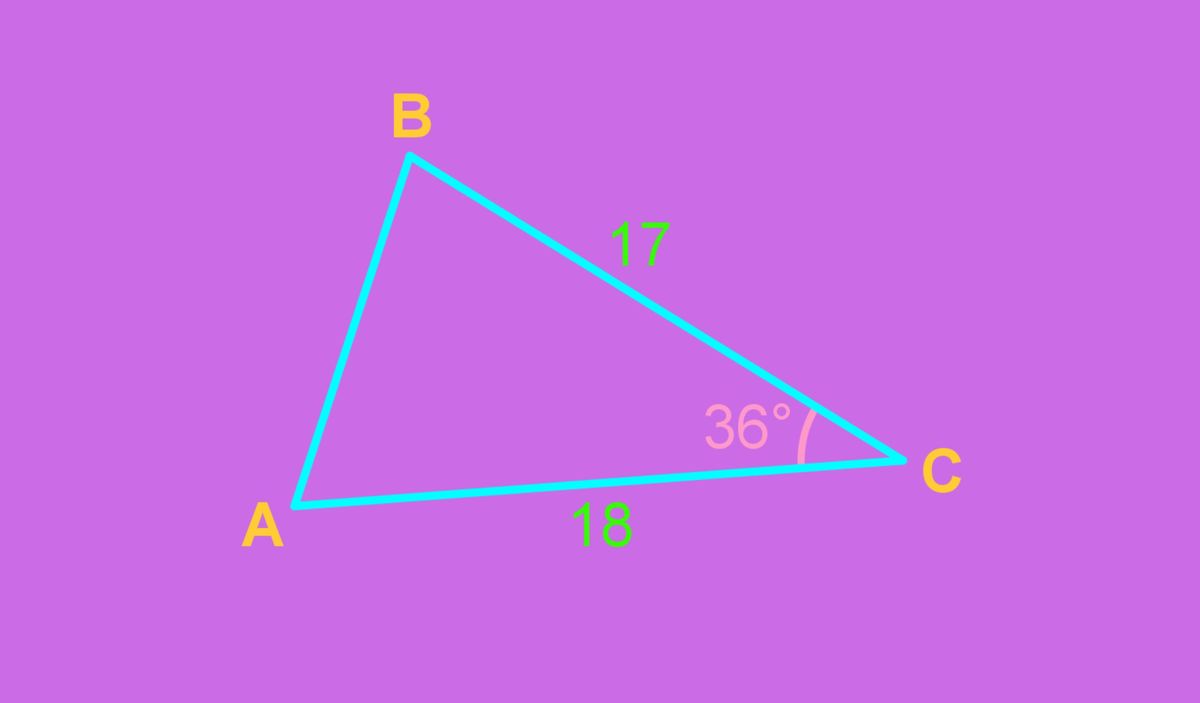In trigonometry, the Law of Cosines (also known as the Cosine Rule) is an important formula used to solve triangles that do not have a right angle. It relates the lengths of the sides of a triangle to the cosine of one of its angles. This formula is a powerful tool for solving a wide range of problems in geometry, physics, and engineering.
In this article, we will explore the Law of Cosines in detail, including its derivation, formula, and applications.
Derivation of the Law of Cosines
The Law of Cosines can be derived using the Pythagorean Theorem, which states that in a right triangle, the sum of the squares of the two shorter sides (the legs) is equal to the square of the longest side (the hypotenuse).
In a non-right triangle, we can still use this idea by drawing an altitude from one vertex to the opposite side. This creates two right triangles, and we can use the Pythagorean Theorem to relate the sides of each triangle.
Let us consider a triangle ABC with sides a, b, and c, and angles A, B, and C, respectively. We can draw an altitude from vertex C to the opposite side AB, splitting the triangle into two right triangles: ACD and BCD.
Using the Pythagorean Theorem in triangle ACD, we have:
AC^2 = AD^2 + CD^2
Using the Pythagorean Theorem in triangle BCD, we have:
BC^2 = BD^2 + CD^2
We can express AD and BD in terms of the sides of the triangle using basic trigonometry. Specifically, we know that:
AD = b sin(A)
BD = a sin(B)
Substituting these expressions into the above equations and simplifying, we get:
AC^2 = b^2 sin^2(A) + c^2 - 2bc cos(A)
BC^2 = a^2 sin^2(B) + c^2 - 2ac cos(B)
Adding these two equations, we get:
AC^2 + BC^2 = b^2 sin^2(A) + a^2 sin^2(B) + 2c^2 - 2bc cos(A) - 2ac cos(B)
Using the identity sin^2(x) + cos^2(x) = 1, we can rewrite the left-hand side as:
AC^2 + BC^2 = 2c^2 - 2ab cos(C)
where we have used the fact that a = AC and b = BC. Combining this with the previous equation, we get:
c^2 = a^2 + b^2 - 2ab cos(C)
This is the Law of Cosines, which relates the length of the side opposite an angle to the lengths of the other two sides and the cosine of that angle.
The formula for the Law of Cosines
The Law of Cosines can be written in several different forms depending on which side and angle we are trying to find. The most common form is:
c^2 = a^2 + b^2 - 2ab cos(C)
where c is the length of the side opposite angle C, and a and b are the lengths of the other two sides. This formula can be rearranged to solve for any of the variables:
cos(C) = (a^2 + b^2 - c^2) / 2ab
a^2 = b^2 + c^2 - 2bc cos(A)
b^2 = a^2 + c^2 - 2ac cos(B)
Applications of the Law of Cosines
The Law of Cosines has many practical applications in geometry, physics, and engineering. Some of the most common applications are:
Solving triangles: The Law of Cosines is particularly useful for solving triangles that do not have a right angle. Given the lengths of two sides and the measure of an angle, we can use the Law of Cosines to find the length of the third side and the measures of the other two angles.
Navigation: The Law of Cosines can be used to determine the distance between two points on the Earth's surface, such as the distance between two cities or the distance traveled by a ship. This is done by treating the Earth as a sphere and using the Law of Cosines to find the distance between two points on the surface of the sphere.
Engineering: The Law of Cosines is used in engineering to calculate the forces acting on structures such as bridges and buildings. By knowing the angles and lengths of the sides of a triangle, engineers can calculate the forces acting on each side of the structure and ensure that it is strong enough to withstand those forces.
Physics: The Law of Cosines is used in physics to calculate the motion of objects that move in a circular path. By knowing the radius of the circle and the angle through which the object has traveled, physicists can use the Law of Cosines to calculate the distance traveled by the object and its final position.
Trigonometry: The Law of Cosines is a fundamental formula in trigonometry and is used in a wide range of applications, from calculating the position of satellites to modeling the behavior of waves and oscillations.
Conclusion
The Law of Cosines is an essential formula in trigonometry and has many practical applications in geometry, physics, and engineering. By relating the lengths of the sides of a triangle to the cosine of one of its angles, it allows us to solve a wide range of problems that would otherwise be difficult or impossible to solve. Whether you are a student learning trigonometry or an engineer designing a structure, the Law of Cosines is a powerful tool that can help you solve complex problems and achieve your goals.

Frequently Asked Questions (FAQs) About The Law of Cosines:
What is the Law of Cosines?
The Law of Cosines is a formula in trigonometry that relates the lengths of the sides of a triangle to the cosine of one of its angles. It can be used to solve triangles, navigate the Earth's surface, and calculate forces in structures, among other things.
When should I use the Law of Cosines?
The Law of Cosines is useful for solving triangles in which the angle and all three sides are known, or in which two sides and the included angle are known. It is also commonly used in navigation and in calculating forces in structures.
What is the formula for the Law of Cosines?
The formula for the Law of Cosines is c^2 = a^2 + b^2 - 2ab cos(C), where c is the length of the side opposite angle C, and a and b are the lengths of the other two sides.
How do I use the Law of Cosines to solve a triangle?
To use the Law of Cosines to solve a triangle, you need to know either the angle and all three sides, or two sides and the included angle. You can then use the formula to calculate the length of the missing side or the value of the missing angle.
What are some applications of the Law of Cosines?
The Law of Cosines is used in a variety of fields, including navigation, engineering, and physics. It can be used to calculate the distance between two points on the Earth's surface, to determine the forces acting on a structure, and to solve problems in mechanics and dynamics.
Are there any limitations to the Law of Cosines?
The Law of Cosines is only applicable to triangles, and it assumes that the triangle is a flat, two-dimensional object. It also assumes that the measurements of the sides and angles are accurate, and that there are no external forces acting on the triangle. In addition, it is important to be aware of rounding errors and other sources of error when using the formula to solve problems.




